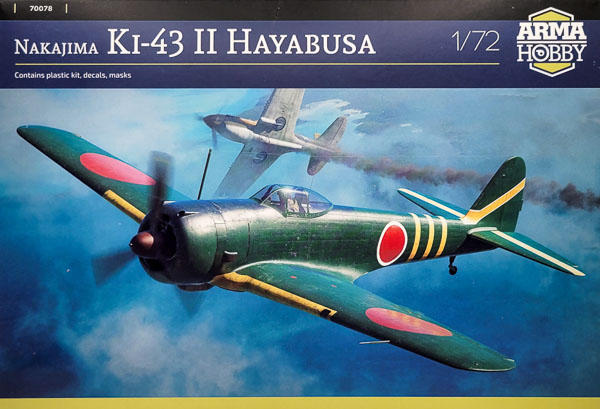
Arma 1/72 Nakajima Ki-43 II Hayabusa
By Chris Banyai-Riepl
Overview
The Nakajima Ki-43 was developed as a successor to the Nakajima Ki-27, itself a popular aircraft. The Ki-43’s light weight and nimble performance made it very popular with its pilots, although the weak armament and lack of armor plating made it easy to shoot down. Despite that, the Ki-43 remained in production throughout the war, with over 5,900 produced between 1939 and 1945.
The Kit
The second Japanese subject from Arma was a surprise, but a welcome one as the current crop of kits, while fairly plentiful, have all had their shares of issues. This kit looks to be the best detailed out of the box Ki-43 kit to date, with the usual excellent detail and engineering in the cockpit and engine and fine, clean surface detailing. There are options for the drop tanks under the wings and choices for the engine exhausts that include different fuselage inserts. Three decal options offer a good variety of schemes worn by the Ki-43, but they only scratch the surface of the marking options on this subject.
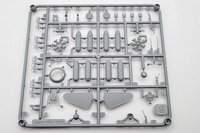
|
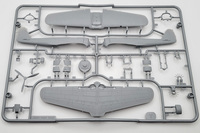
|
Starting with the cockpit, this includes the cockpit floor molded into the upper wing half, sidewall detail molded into the fuselage halves, and a ton of extra separate details. These include boxes & throttle bits for the sidewalls, four pieces for the floor, including rudder pedals and control stick, a rear frame that has a separate seat pan, and an instrument panel with two styles of gunsight options. The majority of the cockpit is attached to the wing, which allows you to assemble the fuselage before adding in the cockpit.
The engine is set up similar to other radial engines in Arma kits, with two individual cylinder banks, a two-piece connecting rod assembly, and a separate crankcase housing. This fits onto the one-piece cowl flap piece that goes on the front of the fuselage. Right behind this are the inserts for the two styles of exhausts, so you will want to pay attention to your references should you opt to build a scheme not from the kit. The cowl itself is built up from four side pieces and a single front ring.
With the wing on and the cowling assembled, the rest of the build will go fast. The rear headrest for the options in the kit decal sheet is made up from three pieces, but there’s also an earlier style that’s a single piece. The landing gear is simple but detailed, with single piece main struts with separate wheels, while the tail wheel is a single piece. The propeller is sandwiched between a two-piece spinner, and the canopy is in two pieces, allowing for an open or closed cockpit. There are two styles of drop tanks, and two styles of pylons. The pylons are interesting in that the sway braces are molded in place and the instructions have you twist them 90 degrees to be in the correct orientation.
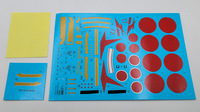
|
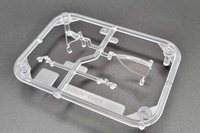
|
The decal options provide a fully camouflaged aircraft, a partially camouflaged aircraft, and a natural metal aircraft. The camouflaged aircraft is a Ki-43 II from the 59th Hiko-Sentai, 3rd Chutai, in New Guinea in 1943-44. The upper surface is overall green, with the underside unpainted metal. This aircraft has three yellow stripes around the rear fuselage and white-outlined yellow stripes on the vertical fin and stabilizers.
The partially camouflaged aircraft is a Ki-43 II from the 54th Hiko Sentai, 2nd Chutai, flown by Hisashi Koshiishi in the Kuril Islands in 1944. This plane is overall natural metal, with patches of dark green on the upper wings & tailplanes and running in light spots along the fuselage. There’s a white and red band around the rear fuselage and a red swoosh motif on the tail. This is centered around the stabilizers, and the instructions indicate you should leave those off until after painting and decaling.
The third option is a Ki-43 II from Hiko Dai 71st Sentai at Hofu Airfield, Japan in late 1944. This plane is finished in overall natural metal with white bands behind the hinomarus. This option also has a red design on the vertical fin and a red 17 on the rudder. All of the options have yellow identity stripes on the wing leading edge and black anti-glare panels. The decals themselves are nicely printed and if they’re anything like other Arma kits, they’ll go down beautifully.
Conclusion
This is another great release from Arma and will look great sitting next to their Ki-84 Hayate. I’m sure it won’t be long before we see aftermarket decal sheets for this kit as well, as there’s a lot of colorful options for the Ki-43. Hopefully Arma will expand on this kit and come out with a Ki-43 I and a Ki-43 III as well, adding to the marking potential of this attractive aircraft. My thanks to Arma for the review kit. Visit their website to pick one up, or your local hobby shop.
